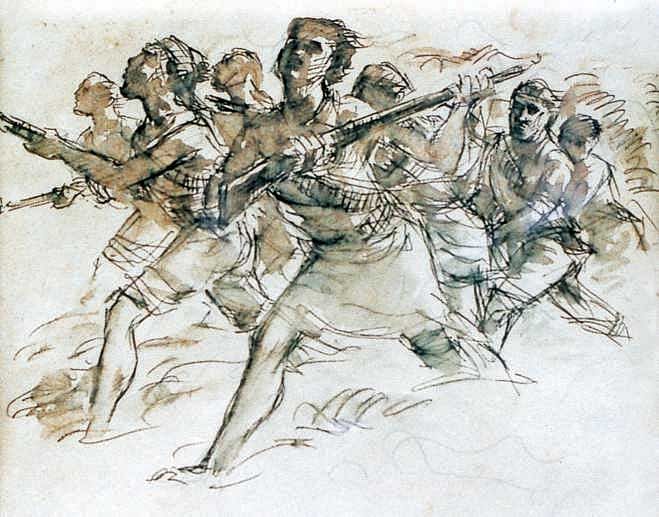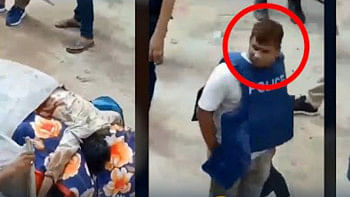Road to Freedom

January 1971. Academic activities had just begun at Tumilia Boys' Primary Government School. After few weeks of classes, school was suspended as the overall situation of the country deteriorated; the liberation war began within weeks. I was a student of grade one. I was just a kid but I can never forget those momentous days of my life.
The village I grew up in was East Bhadarty (North Bhadarty in government documents) It was located west of Kaligonj Upazila, west to the power house of Kaligonj Muslim Cottom Mill and south of Arikhola railway station. There were several quarters in the power house complex for engineers and guards. In 1971, the Muslim Cotton Mill was in operation employing about three thousands workers. Arikhola Railway station, meanwhile, was one of the most crowded places as it was the only centre for transportation. During the liberation war, the Pakistani Army set up a base and an observatory tower in the power house complex and deployed platoons of their soldiers. These platoons coordinated different operations of Pakistani military around Kaligonj and Tumilia regions.
East Bhadarty had two main areas, one dominated by Muslims and the other by Christians. Mr Shrewd (pseudonym), a resident of East Bhadarty, was a collaborator (Razakar) of the Pakistani military. We knew his family very well. He used to take the Pakistani army around the villages. Sometimes he brought them to our village and collected green coconuts, chickens, and other things from the villagers. My family knew Mr. Shrewd well; he used to bring Pakistani military personnel to our house and took tea several times. My father had to give them company but we used to leave home and hide. I remembered an incident clearly. It was a day in early April. My mother and sister were making puffed rice in the kitchen around noon. Mr. Shrewd came with a Pakistani army officer. My father offered a seat in our veranda. Seeing them, my mother and sister closed the door of the kitchen and hid in a corner. The puffed rice in the oven was burning; they were scared to death, but did not dare to move. The smoke of burning puffed rice was coming out.
Later, Mr Shrewd died in a fight between local freedom fighters and Pakistani militaries.
***
In Kaligonj region, there were a number of markets places - Kaligonj haat, Sadhur haat, Som bazaar, and Noya bazaar. Wholesalers, retailers, villagers, and buyers used to gather around 1 pm for at Kaligonj haat on Mondays and Fridays, Sadhur haat on Tuesdays, Som bazaar on Wednesdays, and Noya Bazaar on Thursdays. All these bazaars had some permanent shops. However, Kaligonj retail marketing took place every day in the morning for local people. One Friday in late April in the evening, our village was suddenly attacked with bullets coming from the Kaligonj powerhouse. I, along with our family members, took shelter in between two houses, crouching down for safety from those terrifying bullets. Later I heard that two Pakistani soldiers were returning to the Kaligonj base by Sadhur haat and the local people had snatched away their rifles and beat them. Hearing this news, the Pakistani Army retaliated by firing into the village with their machine guns.
Our home was about two kilometres south of Arikhola railway station and west of Kaligonj Muslim Cotton Mills powerhouse and we could see both from our house. This powerhouse was the main base of the Pakistani Army in that area. One day in early May, around noon, several young local freedom fighters (Muktibahini) came and told us to leave our homes and vacate the area immediately. They were on an operation to attack the Pakistani military base located in the powerhouse. We picked up necessary things, including a half-cooked meal, left out home and went to the Tumilia Church compound for shelter. We found many other people who were already there taking shelter. The church compound included Tumilia Catholic Church, rectory (priests' residence), SMRA sisters' convent, and St. Mary's Girls' High School. It became our home for some time until it was bombed.
People in the shelter were in constant fear and always vigilant. One day, there was a frightful sound of the fighter-bombers flying dangerously low. People at the shelter started to run helter skelter in panic. Within minutes, the fighter-bombers dropped several bombs in the church compund (in between the old church and sisters convent). There was the sound of a partial explosion but then silence. After a while, people of the shelter came out slowly and discovered unexploded bombs buried in the ground. Fortunately the bombs did not explode but the shelter was no longer safe and we had to flee again. My family and I moved to Chorakhola, a village a few kilometres southwest from the church compound.
During the liberation war people - irrespective of creed and religion, went out of their way, taking huge risks to their lives, to help those in need of shelter. We took shelter in one of our relatives house in Chorakhola. First we dug a bunker and covered them with branches and leaves camouflage them. While in Chorakhola, we did not have to use the bunkers much as no attacks took place. But in late June news came that this village too had become vulnerable and it was time to move again.
Our last destination was Bhasania, a village in Ulukhola-Mothbari areas. This village seemed as if it was hidden in the jungle and not visible from outside which made it an ideal shelter. We took shelter in one of our relatives houses. The house was made of mud walls and full of fruit trees. But one day, probably in September or October, two planes were sighted in the sky and our hearts were filled with apprehension. Suddenly we saw a huge fire around one of the planes and heard a sound of explosion. Later we heard that the plane had exploded and fell in a place called Birtul, in an open field, several kilometers from the village we had taken refuge in.
***
It was now November, winter was approaching. The nights were cold because of the trees all around the village. There was plenty of date juice to drink. One day in the morning, I heard people whispering about the military coming, their faces pale with panic. Suddenly, I saw a platoon of military walking through the village paths. I thought we were finished - they were going to kill us all. Eventually it was discovered that they were Indian army who had come to help Bangladeshi freedom fighters. People of the villages came out with food, drink, anything that would help. I went out to see and was eager to do my bit too. One of the armies gave me a small box to carry. The box was small but very heavy, later I found out it was a box of ammunition.
***
Returning home in independent country
The radio was the only medium that could give us news of the war. We got the news that the Pakistani army had surrendered to the joint-forces and Bangladesh was liberated on December 16, 1971. I saw people cheering and clapping and shouting in relief, joy and hope.
It was probably December 17 or 18 that we returned home - East Bhadarty, Kaligonj after several months. From our house, Kaligonj powerhouse and the road that goes to Dhaka were visible. I went with other people of our village to see the welcome sight of the Pakistani soldiers who had based themselves at the Kaligonj powerhouse being taken towards Pubail as prisoners of war by the freedom fighters.
It was a painful yet incredible experience, living in constant fear, moving from place to place for safe shelter during those tumultuous months. The Liberation War that started in March and ended in December 1971 had left a legacy of scars, memories of extreme suffering and grief but also of courage, glory and sacrifice. From time to time, I recollect those days and feel proud to be a part of the generation of independent Bangladesh and to be a Bangladeshi.

 For all latest news, follow The Daily Star's Google News channel.
For all latest news, follow The Daily Star's Google News channel. 




Comments